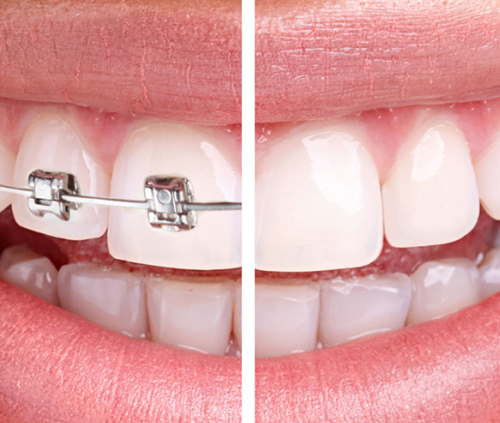Types of dental braces
Good alternatives are becoming available for people who want to hide their metal braces. One example is clear clay braces, which look like metal braces in size and shape but are made of porcelain.
These are the four most common types of tooth braces:
Traditional Metal Braces
Conventional metal braces are the most effective and cost-effective way to straighten teeth.
They straighten the teeth, fix crowded teeth, and straighten the jaw. Orthodontists are skilled at moving teeth in small steps during regular checkups. For kids and teens, traditional braces are the best option. Adult options are also available for people who don’t mind having metal frames shown.
Braces made of metal can cost anywhere from $3,000 to $7,000.
Clear Braces
Clear braces, invisible or ceramic braces, are the same size, form, and function as regular braces.
The main difference between the two types is that ceramic braces have tooth-colored brackets. This makes them less noticeable because they fit in with natural teeth. Clear braces’ stretchy parts and rubber bands are also see-through or white. Both adults and teens can wear invisible braces.
You can expect to pay a little more for clear or ceramic braces. The price range could be between $4,000 and $8,000.

Types of dental braces
Lingual Braces
Lingual braces are an option to traditional metal braces that few people know about. One big difference is that the wires and braces are attached to the back of the teeth, which makes them almost impossible for outsiders to see.
Lingual braces are the same in hardware and method as traditional “exterior” braces, the only difference being that they are placed behind the teeth instead of in front of them.
There are other choices, but lingual braces are more expensive because they are harder to put in. You can expect to pay around $8000 to $10000.
Self-Ligating Braces
Traditional metal braces are a lot like self-ligating braces. Still, there is one big difference: the brackets keep the wires in place instead of using metal or elastic connections (ligatures).
When you go in for an adjustment for standard braces, the ligaments are usually changed. Self-ligating brackets can be changed without buying new parts because they work as ligatures.
These unique brackets can be used in passive (sliding into place) or active (pressing down on the wires) designs. Either way, they can cut down on their time at the dentist. Compared to standard orthodontics, they may also be less painful and make it easier to clean your teeth.
Self-ligating braces are about the same price as regular braces, with the possibility of a slight price rise. Costs should be between $3,000 and $8,000.
Clear Aligners
Many people also use Invisalign and other clear aligners, which are “invisible” dental treatments. They can be taken off and only require minor cuts.
Often, at-home frames can be bought for a lot less than traditional metal braces, even though they may cost the same. You can only wear each unique aligner for three weeks at a time.
Clear aligners move teeth by tiny fractions of a millimeter at a time and cut down on the number of dentist visits. Teenagers and adults often choose braces, especially when their misaligned teeth aren’t too bad.



Leave a Reply
Want to join the discussion?Feel free to contribute!